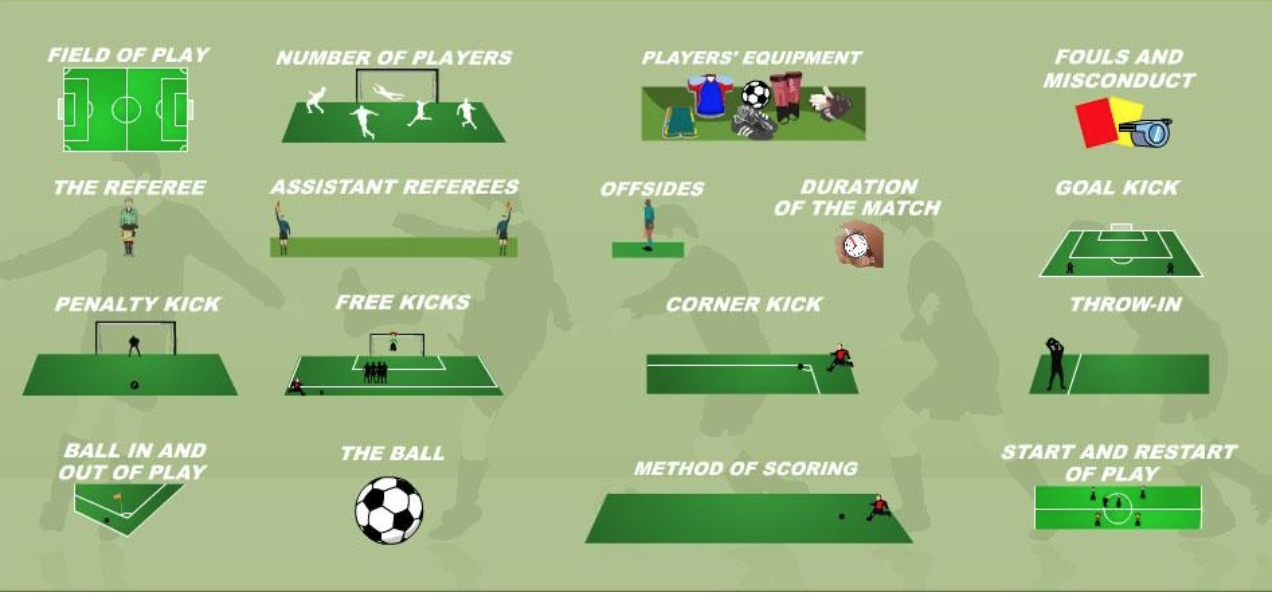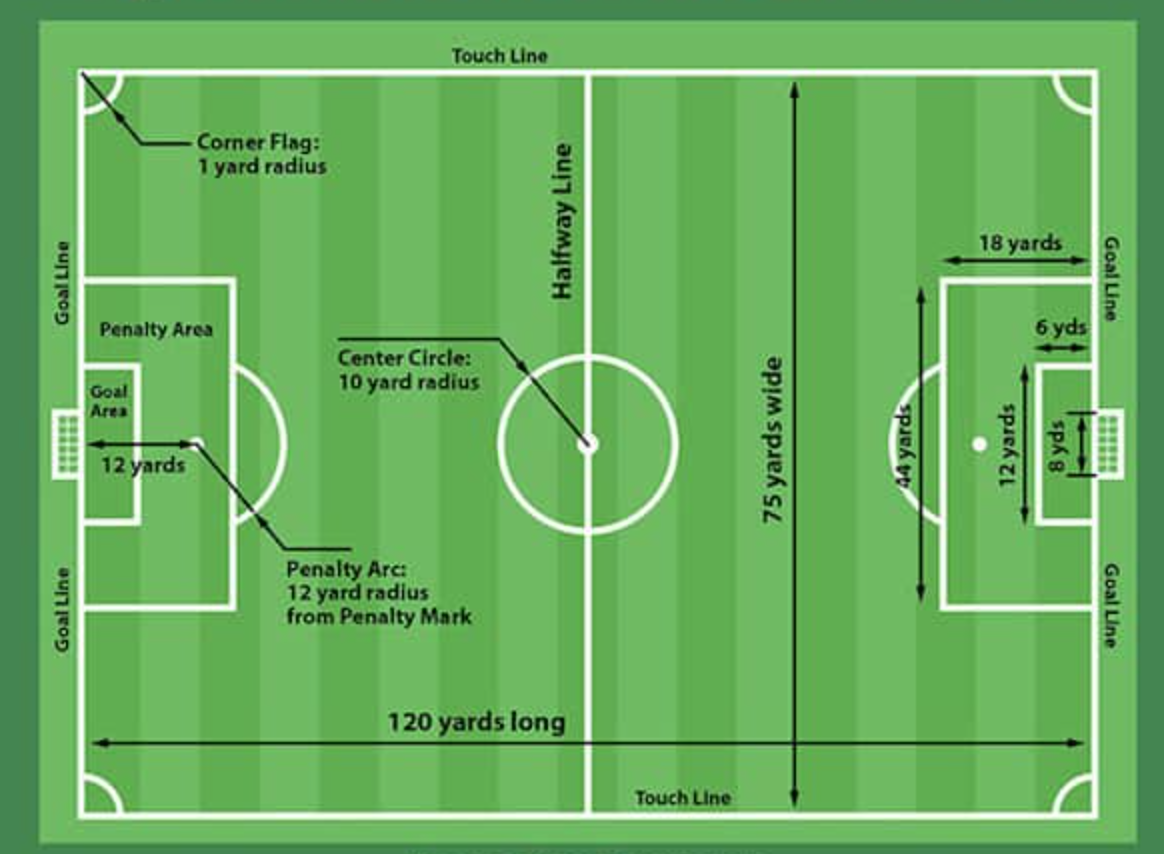Still Looking For Basic Soccer Rules? That's A Yellow Card For You!

That's a rule?? Common ref you don't even know the basic soccer rules of the game they've been doing the same thing to us all game!! Oh the beautiful rules of the game that everyone thinks they know better than everyone else.
Let's stick the basics today so next time you're on the pitch and referee makes a call you can nod and smile in agreement. Everything you've ever wondered about the game from the basics (number of players, game time, uniforms, fouls, the ball, field & goal dimensions and everything else in between.
These basic soccer rules whether learning for the first time or refreshing your memory can serve you really well if you're playing, coaching, officiating or just watching the game as a spectator. If you want to get all specific and review all the official laws in details feel free to find them here.
Basic Soccer Rules Video
The Basics
Field Of Play

The first of the basic soccer rules for the field of play states that the field must be in a rectangular shape with 4 connecting lines along the perimeter that measure 110-120 Yards Long and 70-80 Yards Wide.
- Touch Line - Two vertical lines on each side.
- Goal Line - Two horizontal lines on each end.
- Half Way Line - 1 horizontal line diving the field in half.
- Penalty Area - 18 yards long and 44 yards wide.
- Goal Area - 6 yards long and 12 yards wide.
- Penalty Spot - 12 yards from goal line.
- Penalty Arc - 12 yard radius from penalty mark.
- Center Circle - 10 yard radius.
- Corner Area - 1 yard radius.
- The Goal - 8 yards wide and 8 feet high.
Number Of Players & Teams
Number Of Teams
- Each game consists of two teams. I'm hoping that was an easy one.
Number Of Players
- Every team consists of 11 on field players (1 of those 11 players on each team is the goalkeeper who is the only one that can use their hands inside the penalty area).
- Each team is granted anywhere between 7-9 substitutes depending on the level and country you are playing at. At the professional level it's 3 subs or 3 substitution windows where you can do more than one sub at that time.
- Each team is typically allowed to have 4-6 staff members on the bench as well. Total number of people (staff and players) is typically set at 25.
- These basic soccer rules around number of players and teams is a must know for any beginner to the game.
Players Equipment

Oh no forgot my shin pads again! No problem I'll just fold up some cardboard in my socks again, hey pass me that poster off the wall.
Sometimes you have to improvise and no basic soccer rules book will teach you that.
Outfield Player
- Uniform - Matching shirt, top and socks with your teammates with unique number on the back of the shirt.
- Footwear - Whether it is cleats for grass or turf shoes for turf fields you need one or the other to be able to play.
- Shin Guards - Ya I know nobody wears them at training but to play the game you need shin guards on both legs that go up to 2 inches before the knee (no official will really check the size of these so don't worry too much if they aren't exact).
Goalkeeper
- Uniform - Distinctly different colour than their own team as well as different than the opponents outfield players and goalkeeper.
- For example if you are the keeper and your team is dark blue and the opponents outfield players are in white and the opponents goalie is wearing yellow you can't wear dark blue, white or yellow.
- In this situation wearing a bright pink, green or orange would work perfectly.
- Footwear - Same as out field players goalies are required to wear cleats or turfs depending on the surface.
- Shin Guards - Once again same as outfield players goalkeepers are required to wear shin guards that go up to 2 inches from their knee.
- Gloves - Goalkeepers are not required but highly encouraged to wear gloves on their hands during a match.
The Officials

As much abuse as officials may take from time to time they are vital to the success, order and growth of the game.
I've always loved the saying that there are 3 teams on the field, the team of officials as the third of course.
Even though we all think we know the basic soccer rules of the game, it's always good to have a refresher, here is what you ned to know about the officials on the pitch.
Head Official
- Also knows at the middle or center official has the final call on all decisions.
- They of course use the advice and opinions of their officiating crew but at the end of the day they make the final call.
- They are in charge of dealing with all on field decisions, giving out yellow and red cards and removing any coaching staff or players from the bench.
- They are also in charge of the time keeping for each half along with the amount of injury time that is added to each half.
Assistant Referee (Linesmen)
- The linesmen occupy half of the field along the line on opposite sides of the pitch.
- Their roles include calling offside, calling out of bounds and assisting the middle official on calling fouls which they have a better angle to see.
- Their recommendation goes a long way to the middle official calling fouls, hand balls and even yellow and red cards.
Fourth Official
- The fourth official is the official that stands at the half way line off of the field and is in charge of controlling substitutions, making sure both benches are behaving and finally making sure substitutes are warming up in the correct place and in the correct manor.
- Fourth officials like all the officials also add another set of eyes to the pitch and can recommend calls to the head official they may miss.
VAR Officials
- Video Assistant Referee (VAR) is a fairly new addition to the game at the professional level.
- Although it is still a work in progress the VAR officials are required to review any plays that are classified as game altering such as a goal scoring opportunity or a potential red card.
- Once they quickly do this they recommend to the head official that they have a second look at it should their review differ then the original call made on the field.
Although many people think they know the basic soccer rules of the game which is fair it is the officials who need to know every rule inside and out.
When we watch on TV it may look easy but being a high level official is an extremely difficult job which is constantly evolving.
The Number Of Officials Used At Each Level
- Youth Level - At the youth level there is typically one head official and two linesmen.
- University/College Level - At the collegiate level there is typically the same as the youth level with the addition of a fourth official at half way.
- Professional Level - At the professional level you have the head official, two linesmen, the fourth official and typically four VAR officials upstairs in a video room.
Offside
You are about to swim into the deep and dark waters of the offside rule, on the surface it seems pretty straight forward but after playing and watching it unfold in front of your eyes you will begin to form a love hate relationship with it.
We are going beyond just the basic soccer rules now so let me try and break it down for you as easily as I can.
What Is Offside Exactly?
- To give it to you straight, an offside is when an attacking player receives a ball passed to them from a teammate while they are in behind the 2nd last defender of the opposing team.Seems kinda simple right?
- You can start your run before you reach the second last defender but when the ball is played you must be behind them but it's okay to continue your run and receive it behind them.
Why Is It So Confusing?
- The reason people find this rule so confusing is for a couple of justified reasons. The first is if even one part of your body that can score is in an offside position it is considered offside so it's hard to see that sometimes which causes confusion.
- The second is that one player could be offside but the referee doesn't call it because they weren't interfering with the play and here comes that area of grey everyone loves.
- Lastly and maybe most confusing is if the keeper happens to run out of their goal past the defender closest to them they now become the last defender and the new offside line. If your head is exploding right now, your'e welcome.
Basic Soccer Rules For All Restarts
(Goal Kick, Corner Kick, Penalty Kick, Free Kick & Throw In)
Goal Kick
- Taken from anywhere inside the 6 yard by 12 yard goal area while the ball is stopped dead.
- Occurs when the opposing team touches the ball last as it crosses the end line out of bounds.
Corner Kick
- Taken from anywhere inside the 1 yard radius in the corner kick area while the ball is stopped dead.
- A team is awarded a corner kick when the defending team is the last to touch the ball before it crosses the end line out of bounds of their own net.
Penalty Kick
- Commonly referred to as a penalty, penalty shot or simple PK is taken from the penalty mark which is 12 yards from the goal line.
- A penalty kick is awarded when the attacking team is fouled inside the defending teams penalty area.
Free Kick (Direct & Indirect)
- A free kick can come in two types both direct and indirect.
- They are both awarded after the attacking team gets fouled anywhere on the field excluding the penalty area.
- Both require the defending team to stand 10 yards away from the ball in every direction.
- The only difference between a direct and an indirect free kick is that an indirect free kick must be touched twice before it enters the net while direct free kicks only needs to be touched once.
Throw In
- Throw ins are taken when the ball leaves the field on either side line, the team that didn't touch it last gets to throw the ball back in.
- A throw in is executed while keeping both feet on the ground with both hands on the ball bringing the ball all the way behind your head and forward in one fluid motion.
Match Duration & Structure
Each match is 90minutes long divided into two 45 minute halves. After each half the official will decide to add anywhere from 0 to 6 minutes typically if necessary due to injuries and other unforeseen stoppages in play that needs to be made up at the end of the half. This is the most basic of all basic soccer rules so knowing this is standard for all lovers of the beautiful game.
The Ball

- Size - At all levels at 15 years and above the ball being used is to be a size 5 regulation ball.
- Ball Dimensions - In circumference (around) the ball is to between 27 and 28 inches while the diameter is to be between 8.6 to 9 inches.
- PSI Level - Balls must be pumped between 8.5 and 15.6 psi.
You won't have to worry about any of the basic soccer rules that revolve around the ball, unless you are a ref that is. If you're a player or a coach just show and play.
Method Of Scoring
Put the ball in the net, any questions? Okay let's get serious and talk about the details of scoring and the ways in which you can and cannot score.
Basic soccer rules around scoring seem pretty straight forward but just in case have a quick read.
Ways You Can Score
- During the run of play or set pieces while being onside you can score by getting the ball fully (not just a part of the ball the entire ball must cross the line) across the line by using any body part besides your hand.
- Goals can come from the run of play, corners, free kicks, penalty kicks, goal kicks and yes sadly own goals (when the team puts into their own net).
Ways You Can't Score
- Off of your hand.
- Directly off of a throw in.
- Directly in on an indirect free kick.
- Being in an offside position.
Is Diving Okay?
Depends who you ask. There is no doubt that diving is and always has been part of the game. In my opinion there are two types of diving or embellishing a call. Now this goes beyond the everyday basic soccer rules and enters the realm of unwritten rules, enjoy.
Diving
- Hardly getting touched or not touched at all and flopping around holding your head and neck like you got shot.
Embellishing
- If you get hit and can possibly stay on your feet but the player definitely fouled you and you go down and get the call.
- The second example is much more acceptable and respected as a fair action and play on the players part.
- The first example although passes can give you a bad reputation and lose credibility with the official should he spot your antics.
- Stick to the embellishing and avoid the diving whenever possible, no more basic soccer rules for you, time for the dark arts of the game.
Top 5 Most Complicated Basic Soccer Rules Most People Don't Understand
1. The Offside
2. The Hand Ball
3. The Goal Kick
4. Indirect Free Kick
5. Injury Time

